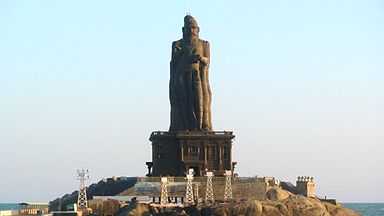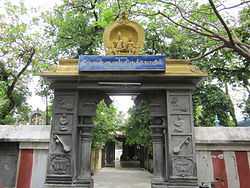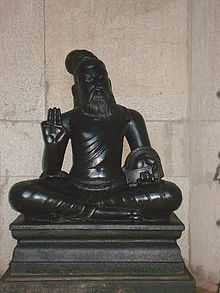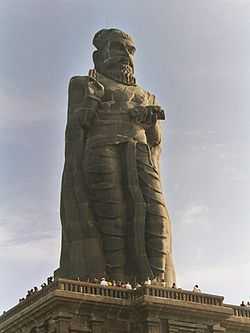Thiruvalluvar

Thiruvalluvar(Tamil: திருவள்ளுவர், Tiruvaḷḷuvar ?), is a celebrated Tamil poet and philosopher[1] whose contribution to Tamil literature is the Thirukkural, a work on ethics.[2] He was born in Kanyakumari district, Tamil Nadu.[3] Thiruvalluvar is thought to have lived sometime between the 1st century BC and the 8th century AD. This estimate is based on linguistic analysis of his writings, as there is no archaeological evidence for when he lived.[4] He is sometimes also called Theiva Pulavar ("Divine Poet"), Valluvar, Poyyamozhi Pulavar, Senna Pothar,Gnana Vettiyan or Ayyan.
Traditional accounts

Tirukkuṛal itself does not name its author or authors. The name Thiruvalluvar is first mentioned in the 10th century in a text called Thiruvalluvarmaalai ("Thiruvalluve traditions of Thiruvalluvar" appeared after this text had been written.[5] It is generally believed that the name Thiruvalluvar consists of Thiru (a Tamil word meaning honorable, similar to Mr rather to the Sankrit word Shree)[6] and Valluvar (a polite name for Valluvan, according to Tamil tradition). The name Valluvan is a common name representing his caste or occupation rather than his proper name. However, it is not known whether the author of Tirukkuṛaḷ (Valluvan) was named after his community, Valluvar or vice versa.
There are several claims regarding where he lived, but none of them have been verified. One legend associates him with Madurai, the ancient capital of the Pandya rulers who vigorously promoted Tamil literature. According to another he was born in Mylapore, a part of present day Chennai(Madras), and traveled to Madurai to submit the Thirukural, for approval of the king (Pandian) and his college of poets.[7] The word 'Thiruvalluvar' might also be a Tamil equivalent of Sanskrit 'SriVallabhan' a common Pallava name from the Pallava region of ThiruMayilai (Mylapore) in Chennai. He has been said to have been a weaver and the supposed house he lived is now converted to a temple. His wife's name is supposed to be Vaasuki Ammaiyar. There are lots of legends about the pair Thiruvalluvar and Vaasuki. Two of them are, 1) Once Vaasuki ammaiyar was drawing water from well and Thiruvalluvar called her and she left the water and ran in immediately, but the water pot stayed in mid air. Such was her austerity and dedication towards her husband Thiruvalluvar. 2) Thiruvalluvar used to sit everyday for meal with a cup of water and a wooden tooth pick. He did this to pick any grain of rice spilled out from his leaf when Vaasuki Ammaiyar served food. It was said that Thiruvalluvar could not even pick a grain of rice every day. Such was the dedication in serving meal by Vaasuki Ammaiyar. Thiruvalluvar may have spent part of his life in Madurai because it was under the Pandiya rulers that many Tamil poets flourished. There is also the recent claim by Kanyakumari Historical and Cultural Research Centre (KHCRC) that Valluvar was a king who ruled Valluvanadu in the hilly tracts of the Kanyakumari District of Tamil Nadu.[8] [9]
Thirukkural

Thirukkural is one of the most revered ancient works in the Tamil language. It is considered a 'common creed',[10] providing a guide for human morals and betterment in life. Thirukkural has been translated into several languages,[11] including a translation into Latin by Constanzo Beschi in 1730, which helped make the work known to European intellectuals.
Thirukkuṛaḷ is a combined word formed by joining the two words Thiru (meaning revered) and Kural (is a form of poem writing style, like Ballad in English Poems. Other forms of poem writing styles in Tamil are Venpa, Yaappu etc.).
Thirukkuṛaḷ is divided into three sections: section one deals with Aram, good ethical behavior with conscience and honor ("right conduct"); section two discusses Porul, the right manner of conducting worldly affairs; and section three dwells on Inbam, love between men and women. The first section has 38 chapters, the second 70 chapters and the third 25 chapters. Each chapter consists of 10 couplets or kurals, for a total of 1330 couplets. Although two sections, Aram and Inbam, are devoted to the private life of an individual more than half the couplets in Thirukural are grouped under Porul which discusses ethics in public life. Thus Thiruvalluvar gives more importance to righteous living in public life.
Thiruvalluvar statue
The Thiruvalluvar Statue is a 133 feet (40.6 m) tall stone sculpture of the Tamil poet and saint Tiruvalluvar, author of the Thirukkural. It was opened on 1 January 2000 (Millennium) and is located atop a small island near the town of Kanyakumari, where two seas and an ocean meet; the Bay of Bengal, the Arabian Sea, and the Indian Ocean . The statue has a height of 95 feet (29 m) and stands upon a 38 foot (11.5 m) pedestal that represents the 38 chapters of "virtue" in the Thirukkural. The statue standing on the pedestal represents "wealth" and "pleasures", signifying that wealth and love be earned and enjoyed on the foundation of solid virtue.The combined height of the statue and pedestal is 133 feet (40.5 m), denoting the 133 chapters in the Thirukkural. It has a total weight of 7000 tons.The statue, with its slight bend around the waist is reminiscent of a dancing pose of the ancient Indian deities like Nataraja.
Other works
Other than the Thirukkuṛaḷ, Thiruvalluvar is alleged to be the author of two Tamil texts on medicine, Gnana Vettiyan and Pancharathnam; although many scholars claim that they were by a later author with the same name,[12] since they appear to have been written in the sixteenth and seventeenth centuries.[13]
Memorials

A temple-like memorial to Thiruvalluvar, Valluvar Kottam, was built in Chennai in 1976.[14] This monument complex consists of structures usually found in Dravidian temples,[15] including a temple car[16] carved from three blocks of granite, and a shallow, rectangular pond.[14] The auditorium adjoining the memorial is one of the largest in Asia and can seat up to 4000 people.[17]
There is a 133-foot tall statue of Thiruvalluvar erected at Kanyakumari at the southern tip of the Indian subcontinent, where the Arabian Sea, the Bay of Bengal, and the Indian Ocean converge. The 133 feet denote Tirukkuṛaḷ's 133 Chapters or athikarams and the show of three fingers denote the three themes Aram, Porul, and Inbam, i.e. the sections on Morals, Wealth and Love. The statue was designed by V. Ganapati Sthapati, a temple architect from Tamil Nadu.[18] His statue was unveiled in Ulsoor, near Bengaluru, on 9 August 2009 also,making it the first of its kind for a poet of a local language to be installed in its near states other than his own home land at India. There is also a statue of Thiruvalluvar outside the School of Oriental and African Studies in Russell Square, London.[19]
The government of Tamil Nadu celebrates the 15th (16th On Leap Years) of January as (as Per Tamil Calendar தை-2) Thiruvalluvar Day as part of the Pongal celebrations in his honour.[20]
See also
| Wikimedia Commons has media related to Thiruvalluvar. |
| Wikiquote has a collection of quotations related to: Thiruvalluvar |
- Statue of Thiruvalluvar
- Sarvajna
- Vemana
- Sarvajna and Tiruvalluvar statue installation
- Valluvar Kottam
- Ovvaiyar
- Paraiyar
References
- ↑ http://www.dlshq.org/saints/thiruvalluvar.htm
- ↑ "Arts - Literature - Thirukural". Tamilnadu.com. 3 April 2013.
- ↑ "Thiruvalluvar's birth place"
- ↑ Mohan Lal (1 January 2006). The Encyclopaedia Of Indian Literature (Volume Five (Sasay To Zorgot). Sahitya Akademi. pp. 4333–4334. ISBN 978-81-260-1221-3. Retrieved 14 December 2010.
- ↑ Blackburn, Cutler (2000). "Corruption and Redemption: The Legend of Valluvar and Tamil Literary History.". Modern Asian Studies 34: 449–482. doi:10.1017/S0026749X00003632. Retrieved 9 December 2010.
- ↑ Caldwell, Robert. 1875. A comparative grammar of the Dravidian or South-Indian family of languages. London: Trübner.
- ↑ Kanakasabhai (1997). The Tamils Eighteen Hundred Years Ago. Asian Education Service. p. 138. ISBN 81-206-0150-5.
- ↑ "Valluvar lived in Kanyakumari district". Yahoo! News. 26 April 2007. Archived from the original on 28 March 2007. Retrieved 22 August 2007.
- ↑ thu
- ↑ Kamil Zvelebil (1973). The smile of Murugan on Tamil literature of South India. BRILL. pp. 156–. ISBN 978-90-04-03591-1. Retrieved 11 December 2010.
- ↑ "Translation of the Tamil literary work thirukkuRaL in world languages". K. Kalyanasundaram. Retrieved 10 March 2012.
- ↑ Ca. Vē Cuppiramaṇiyan̲ (1980). Papers on Tamil studies. International Institute of Tamil Studies. Retrieved 11 December 2010.
- ↑ Marion Zimmermann (September 2007). A Short Introduction: The Tamil Siddhas and the Siddha Medicine of Tamil Nadu. GRIN Verlag. pp. 8–. ISBN 978-3-638-77126-9. Retrieved 14 December 2010.
- ↑ 14.0 14.1 David Abram; Rough Guides (Firm) (2003). South India. Rough Guides. pp. 421–. ISBN 978-1-84353-103-6. Retrieved 12 December 2010.
- ↑ Tourist Guide to Tamil Nadu. Sura Books. pp. 20–. ISBN 978-81-7478-177-2. Retrieved 12 December 2010.
- ↑ Mary Elizabeth Hancock (8 October 2008). The politics of heritage from Madras to Chennai. Indiana University Press. pp. 113–. ISBN 978-0-253-35223-1. Retrieved 12 December 2010.
- ↑ Rina Kamath (2000). Chennai. Orient Blackswan. pp. 34–. ISBN 978-81-250-1378-5. Retrieved 12 December 2010.
- ↑ Tiruvaḷḷuvar; Satguru Sivaya Subramuniyaswami (1 January 2000). Tirukural. Abhinav Publications. pp. 31–32. ISBN 978-81-7017-390-8. Retrieved 12 December 2010.
- ↑ http://londondailyphoto.blogspot.co.uk/2006/06/tiruvalluvar.html
- ↑ Various. Tourist Guide to South India. Sura Books. pp. 13–. ISBN 978-81-7478-175-8. Retrieved 12 December 2010.
|